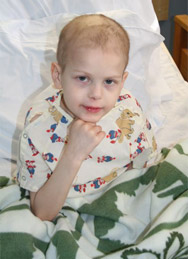| |
 |
 |
ABOUT CHILDHOOD CANCER
What Makes Childhood Cancer Different?
|
 |
Cancer in children is a complex set of diseases, including both blood-born malignancies (leukemia) and soft tissue tumors (lymphomas and sarcomas). However, although these diseases share the same generic label – “cancer” – that describes adult malignant disease, pediatric cancers differ from adult cancers in numerous, specific and significant ways. Many childhood cancers strike only children and young adults (i.e., from newborns through age 18).
Whereas adult cancers frequently originate in specific organs: breast, lungs, prostate, etc., childhood cancers often arise in the connective tissues such as bone and muscle (eg., rhabdomyosarcoma, osteosarcoma, Ewings sarcoma), and in the brain/central nervous system. The most common childhood malignancy is acute lymphoblastic leukemia (ALL), which accounts for almost one third of childhood cancers. The cause of most children’s cancers is not known.
Childhood cancer is generally more aggressive, spreads more quickly, and often has spread from its original site to other parts of the body or major organs before it is ever diagnosed. This renders surgery a less effective treatment option, and increases the importance of chemotherapy and radiation. |
 |
 |
 |
 |
The median age for children when they are diagnosed with cancer is 6 years, for adults it is 67 years. And for the most part children with cancer appear otherwise healthy.
For adults there are screening tests (mammograms, pap smears, PSA measurements) that are designed to aid early detection and enable early treatment and improved long term survival. There are no screening tests for children’s cancer. Often the diagnosis is made during a routine visit to the pediatrician and comes as a complete shock to the family.
Children, in general, have a potentially better prognosis for survival than do adults. But in order for that potential to be realized the diagnosis must be early, the treatment must be prompt and effective. A delay in diagnosis or treatment can, and often does, change the outlook dramatically.
Treatment for childhood cancer is also different than for adults, because the body of a baby, child or young adult is still experiencing growth and significant hormonal and physiological change. This renders the toxicity of chemotherapy and radiation potentially more devastating, as the damages to healthy cells expose survivors of childhood cancer to a host of serious and potentially life-threatening health issues as they grow older.
What is the Scope of the Problem?
Depending upon the statistical source one refers to, childhood cancer is diagnosed in 160,000 to 250,000 new victims around the globe every year. Unfortunately, eighty percent of the children diagnosed live in under developed countries with limited or no access to medical practitioners trained in pediatric oncology. Therefore, almost two-thirds of those children will not survive, even when their cancer is among the most treatable and responsive to treatment. For example, the most common form of childhood leukemia – acute lymphoblastic leukemia (ALL) – is very responsive to treatment and offers an excellent chance for long term survival. Nonetheless, the survival rate in developing countries remains discouragingly low. |
 |
 |
 |
 |
In the U.S. each year approximately 12,000 children are
diagnosed with cancer.
Researchers estimate that 1 out of every 333 children in the U.S. will be diagnosed with cancer before the age of 20. Of those, 75% are likely to achieve long term survival (albeit some with lasting secondary impairments), but 25% will die within 5 years.
And even in the U.S. the prospects for children diagnosed with neuroblastoma, brain stem gliomas, metastatic bone tumors, and acute myelocytic leukemia (AML) are bleak indeed. |
 |
In raw numbers, significantly more adults are diagnosed with cancer each year than children. But when you factor in the years of lost potential for each child that dies from cancer, the loss is far greater than the raw numbers alone suggest. And when you consider the needless loss of children’s lives due to late or wrong diagnosis, late or no access to treatment due to distance, lack of facilities, or economic factors, the need for action becomes clear.
Treating childhood cancer need not be expensive. With proper training and advice to local doctors, and with the development of treatment protocols that are designed to make the best use of a country’s existing medical facilities, significant progress is possible even in countries with limited resources. But someone needs to reach out and show the way.
It truly is a matter of life or death.
Sources:
“Annual Report to the Nation on the Status of Cancer, 1975-2001, with a Special Feature Regarding Survival”, Cancer, fol 101, no 1, July 1, 2004.
Global Action Against Cancer (Geneva: UICC/WHO, updated edition 2005)
Riveiro R.C. & Pui C-H (2005), “Saving the Children – Improving Childhood Cancer Treatment in Developing Countries”, New England Journal of Medicine, 352; 21: 2158-2160.
Steliarova-Foucher E., Stiller C. et al. (2004) “Geographical patterns and time trends of cancer incidence and survival among children and adolescents in Europe since the 1970s (the ACCIS project): an epidemiological study”, the Lancet, 365: 2097-105.
Tenneberger S., Cavalli F., Pannuti F., eds. Cancer in Developing Countries: The Great Challenge for Oncology in the 21st Century (Munich: Zuckschwerdt, 2004).
Vahey, M. (2002) “Childhood Cancers Health Article”, Gale Encyclopedia of Cancer
Burton, A., “The UICC My Child Matters initiative awards combating cancer in children in the developing world”, the Lancet Oncology (2006) 7:13-14.
|
 |
 |
 |
 |
 |
 |
 |
 |
|
|

